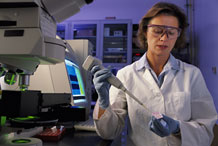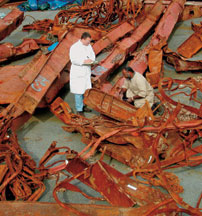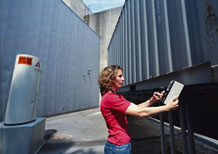Technologies
for Public Safety and Security:
Activities at the National Institute of Standards and Technology
In the
aftermath of the attacks on Sept. 11, 2001, the National Institute
of Standards and Technology (NIST) is playing a key role in
enhancing the nation’s homeland security. Through projects
spanning a wide range of research areas, NIST is helping the
millions of individuals in law enforcement, the military,
emergency services, information technology, airport and building
security, and other areas protect the American public from
terrorist threats.
As a non-regulatory
agency of the U.S. Department of Commerce, NIST develops and promotes measurement,
standards, and technology to enhance productivity, facilitate
trade, and improve the quality of life. As part of this mission,
NIST scientists and engineers continually refine the science
of measurement, making possible the ultraprecise engineering
and manufacturing required for today’s most advanced
technologies. They also are directly involved in standards
development and testing done by the private sector and government
agencies.
| Through
a wide variety of standards committees, NIST is leading
efforts to develop enabling technologies for protecting
dams, bridges, telecommunications networks, water
systems, and the electrical power grid from terrorist
attacks. |
These
capabilities long have provided a foundation for America’s
technological edge in the global marketplace. Now they are
proving vital in the nation’s
effort to develop and implement technologies to prevent,
respond to, and mitigate terrorist attacks.
Below
are examples of NIST’s research, standards development,
and partnership projects related to improving homeland security.
Chemical,
Biological, and Other Threats

© Robert
Rathe
|
A
highly sensitive, inexpensive “lab-on-a-chip” that
provides warning within seconds of even trace
amounts of toxic chemicals in water has been
developed by NIST scientists and collaborators.
|
 With support from the Defense Threat Reduction Agency,
NIST has developed low-cost gas microsensors that can
detect a wide range of toxic chemicals such as mustard
gas and
nerve agents at trace levels. The patented technology
uses nanostructured thin films and mini heaters embedded
in
a microcircuit to generate unique chemical “fingerprints.”
With support from the Defense Threat Reduction Agency,
NIST has developed low-cost gas microsensors that can
detect a wide range of toxic chemicals such as mustard
gas and
nerve agents at trace levels. The patented technology
uses nanostructured thin films and mini heaters embedded
in
a microcircuit to generate unique chemical “fingerprints.”
 NIST researchers are assisting the Centers for Disease
Control and Prevention (CDC) in expanding and assuring the
quality of testing conducted by its five-state Chemical Counter-Terrorism
Laboratory Network. The network of state clinical laboratories
is designed to assist the CDC with testing of urine and blood
samples in the event of a chemical terrorist attack. NIST researchers are assisting the Centers for Disease
Control and Prevention (CDC) in expanding and assuring the
quality of testing conducted by its five-state Chemical Counter-Terrorism
Laboratory Network. The network of state clinical laboratories
is designed to assist the CDC with testing of urine and blood
samples in the event of a chemical terrorist attack.
| A
NIST homeland security expert serves as the
U.S. representative for the International
Organization for Standardization’s
high-level Advisory Group on Security that
is working to identify needs for new or improved
international security standards. |
 NIST building experts used a sophisticated NIST-developed
computer
model to understand how anthrax spores may have spread
through the Hart Senate Office building following an incident
with contaminated mail in October 2001. The modeling results
were used in developing decontamination strategies. NIST expertise
could be applied to the anthrax problem quickly because the
agency long has worked to improve indoor air quality by developing
models that simulate how pollutants, smoke,
and contaminants are transported through buildings.
NIST building experts used a sophisticated NIST-developed
computer
model to understand how anthrax spores may have spread
through the Hart Senate Office building following an incident
with contaminated mail in October 2001. The modeling results
were used in developing decontamination strategies. NIST expertise
could be applied to the anthrax problem quickly because the
agency long has worked to improve indoor air quality by developing
models that simulate how pollutants, smoke,
and contaminants are transported through buildings.

© Robert
Rathe
|
An
interdisciplinary NIST research team is developing
a high-speed, “quantum
key” encryption system. Messages sent through
the system cannot be intercepted without detection.
|
 Continually improving methods and data for ultrasensitive
detection of chemicals, including chemical warfare agents,
is a major goal for NIST chemists. A NIST database
developed with the Environmental Protection Agency and the
National Institutes of Health provides the chemical data needed
to identify more than 140,000 different compounds. The database
is essential for rapidly responding to chemical threats at
airport checkpoints and in other homeland security applications.
Continually improving methods and data for ultrasensitive
detection of chemicals, including chemical warfare agents,
is a major goal for NIST chemists. A NIST database
developed with the Environmental Protection Agency and the
National Institutes of Health provides the chemical data needed
to identify more than 140,000 different compounds. The database
is essential for rapidly responding to chemical threats at
airport checkpoints and in other homeland security applications.
 NIST recently completed new recommended performance standards
and operational requirements for both walk-through and hand-held
metal detectors. Funded by the National Institute of Justice
(NIJ), the new specifications enhance detection of metal
objects without disturbing cardiac pacemakers or other implanted
medical devices. NIST recently completed new recommended performance standards
and operational requirements for both walk-through and hand-held
metal detectors. Funded by the National Institute of Justice
(NIJ), the new specifications enhance detection of metal
objects without disturbing cardiac pacemakers or other implanted
medical devices.
 A promising
detection method uses low-energy, millimeter-size electromagnetic
waves that easily penetrate clothing but
bounce back from concealed weapons. With funding from NIJ
and the Federal Aviation Administration, NIST researchers
are evaluating the new technology’s effectiveness. A promising
detection method uses low-energy, millimeter-size electromagnetic
waves that easily penetrate clothing but
bounce back from concealed weapons. With funding from NIJ
and the Federal Aviation Administration, NIST researchers
are evaluating the new technology’s effectiveness.
 A number of projects co-funded by NIST’s Advanced
Technology Program have homeland security applications.
In particular, Varian Medical Systems is developing a large-area
digital X-ray inspection system for screening cargo and sealed
freight containers, TechGuard Security LLC is creating a new
type of computer firewall that uses neural networks to help
recognize malicious data traffic, and Infrared Identification
Inc. is working on a new biometric technology that uses thermal
imaging to map unique facial vascular patterns.
A number of projects co-funded by NIST’s Advanced
Technology Program have homeland security applications.
In particular, Varian Medical Systems is developing a large-area
digital X-ray inspection system for screening cargo and sealed
freight containers, TechGuard Security LLC is creating a new
type of computer firewall that uses neural networks to help
recognize malicious data traffic, and Infrared Identification
Inc. is working on a new biometric technology that uses thermal
imaging to map unique facial vascular patterns.
Infrastructure
Protection and Cybersecurity
 Photo
by Kelly Talbott
Photo
by Kelly Talbott |
NIST
structural experts are examining about 250
pieces of steel from the World Trade Center
site as part of an investigation
into the building collapses on
Sept. 11, 2001.
|
 Materials scientists at NIST are collaborating with industry
and academic researchers on test methods for high-performance
concrete and advanced polymer composites that will enable
structures of all kinds to
Materials scientists at NIST are collaborating with industry
and academic researchers on test methods for high-performance
concrete and advanced polymer composites that will enable
structures of all kinds to
better withstand terrorist attacks.
 A two-year, $16 million investigation
of the structural failure and collapse of the World Trade
Center buildings following the Sept. 11 attack is under way
to determine what happened and why. Conclusions from the study
will be used to recommend changes to building and fire codes,
standards, and practices as well as to improve emergency response
and evacuation
A two-year, $16 million investigation
of the structural failure and collapse of the World Trade
Center buildings following the Sept. 11 attack is under way
to determine what happened and why. Conclusions from the study
will be used to recommend changes to building and fire codes,
standards, and practices as well as to improve emergency response
and evacuation
procedures.
 NIST
researchers, working with representatives from the gas,
electric power, water distribution, and process control
industries, have developed several laboratory testbeds to
help in validating improved standards for protecting the
security of control systems. In addition, NIST developed
a Virtual Cybernetic Building Testbed for studying the interaction
of control systems for heating, ventilation, fire alarms,
lighting, and other building areas and to develop improved
security techniques to protect these systems. As part of
this effort, the NIST building experts are working with the
General Services Administration, the Architect of the Capitol,
and others to implement security features in real-life, large-scale
automated building systems networks. NIST
researchers, working with representatives from the gas,
electric power, water distribution, and process control
industries, have developed several laboratory testbeds to
help in validating improved standards for protecting the
security of control systems. In addition, NIST developed
a Virtual Cybernetic Building Testbed for studying the interaction
of control systems for heating, ventilation, fire alarms,
lighting, and other building areas and to develop improved
security techniques to protect these systems. As part of
this effort, the NIST building experts are working with the
General Services Administration, the Architect of the Capitol,
and others to implement security features in real-life, large-scale
automated building systems networks.
 In 2001, NIST and the Department of Commerce introduced the
Advanced
Encryption Standard (AES), the most powerful standard
to date for protecting sensitive, non-classified electronic
information. The private sector is using AES to safeguard
financial transactions and ensure the privacy of digital information—from
medical records and tax information to PIN numbers—for
millions of Americans.
In 2001, NIST and the Department of Commerce introduced the
Advanced
Encryption Standard (AES), the most powerful standard
to date for protecting sensitive, non-classified electronic
information. The private sector is using AES to safeguard
financial transactions and ensure the privacy of digital information—from
medical records and tax information to PIN numbers—for
millions of Americans.
 NIST develops standards and guidelines for all unclassified
federal information systems. These are used widely on a voluntary
basis by those in the private sector. The standards and guidelines
encompass a wide range of technical, operational, and management
controls and address such topics as contingency planning,
risk management, cryptography, sensitivity categorization,
minimum controls, incident handling, and telecommuting security
issues. NIST develops standards and guidelines for all unclassified
federal information systems. These are used widely on a voluntary
basis by those in the private sector. The standards and guidelines
encompass a wide range of technical, operational, and management
controls and address such topics as contingency planning,
risk management, cryptography, sensitivity categorization,
minimum controls, incident handling, and telecommuting security
issues.
Nuclear, Radiological, and Explosive Materials

© Robert
Rathe
|
NIST
led a multiagency effort to develop new standards
for radiation detectors and monitors. Here, a
hand-held device is used to check the cargo of
a truck trailer.
|
 A year-long collaboration of diverse government and private-sector
organizations, led by NIST in cooperation with the Institute
of Electrical and Electronics Engineers (IEEE), produced
standards for radiation detection devices ranging from
pocket-sized alarms to shipping-container-sized portal
monitors. Adopted by the Department of Homeland Security
(DHS), the four standards establish baseline performance
criteria and testing requirements for radiation detectors
used at seaports, airports, and other key spots. A year-long collaboration of diverse government and private-sector
organizations, led by NIST in cooperation with the Institute
of Electrical and Electronics Engineers (IEEE), produced
standards for radiation detection devices ranging from
pocket-sized alarms to shipping-container-sized portal
monitors. Adopted by the Department of Homeland Security
(DHS), the four standards establish baseline performance
criteria and testing requirements for radiation detectors
used at seaports, airports, and other key spots.
 In collaboration with the Transportation Security Agency,
NIST is developing measurement techniques for designing,
characterizing, and calibrating trace explosive detection
systems. The techniques will ensure that equipment for screening
airline passengers, baggage, and cargo operates effectively. In collaboration with the Transportation Security Agency,
NIST is developing measurement techniques for designing,
characterizing, and calibrating trace explosive detection
systems. The techniques will ensure that equipment for screening
airline passengers, baggage, and cargo operates effectively.
 Working with SPARTA Inc. of Rosslyn, Va., NIST demonstrated
a novel technique using far-infrared (terahertz) radiation
to rapidly identify bulk or airborne materials inside sealed
paper or plastic containers. The technology has potential
applications in the detection of explosives in the mail or
other non-metallic portable containers. Working with SPARTA Inc. of Rosslyn, Va., NIST demonstrated
a novel technique using far-infrared (terahertz) radiation
to rapidly identify bulk or airborne materials inside sealed
paper or plastic containers. The technology has potential
applications in the detection of explosives in the mail or
other non-metallic portable containers.
Biometrics
and Forensic Tools

© Robert
Rathe
|
Based
on a concept developed by a NIST scientist, a new
technique for analyzing
degraded DNA fragments led to the identification
of Sept. 11 victims who could not be identified with
conventional methods.
|
 Through
its work as co-chair of the Biometrics Consortium, NIST
has been instrumental in developing
and implementing
a common biometric exchange format that allows all biometric
systems to share data. The Biometric Consortium has more
than 80 members, including 60 government agencies, and
serves as a focal point for research, development, evaluation,
and implementation of biometric technologies. Through
its work as co-chair of the Biometrics Consortium, NIST
has been instrumental in developing
and implementing
a common biometric exchange format that allows all biometric
systems to share data. The Biometric Consortium has more
than 80 members, including 60 government agencies, and
serves as a focal point for research, development, evaluation,
and implementation of biometric technologies.
 NIST has statutory responsibility under the USA Patriot Act
to develop and certify a technology for verifying the identity
of travelers entering the United States with a visa. NIST
biometrics experts recently recommended
(.pdf;
download Acrobat Reader)
that at
least two fingerprints, as well as photographs and facial
recognition systems, be used for this purpose.
NIST has statutory responsibility under the USA Patriot Act
to develop and certify a technology for verifying the identity
of travelers entering the United States with a visa. NIST
biometrics experts recently recommended
(.pdf;
download Acrobat Reader)
that at
least two fingerprints, as well as photographs and facial
recognition systems, be used for this purpose.
 A series of NIST Standard Reference Materials can be used
by forensic and commercial laboratories to check the accuracy
of DNA typing analyses used to match evidence samples to
suspects. The standards include samples of human DNA that
have been carefully analyzed according to a standard Federal
Bureau of Investigation (FBI) method. A series of NIST Standard Reference Materials can be used
by forensic and commercial laboratories to check the accuracy
of DNA typing analyses used to match evidence samples to
suspects. The standards include samples of human DNA that
have been carefully analyzed according to a standard Federal
Bureau of Investigation (FBI) method.
| Data
collection efforts and tests conducted by NIST facial
recognition experts in conjunction with other federal
agencies are helping private companies improve computer
programs that “recognize” human faces. Error
rates dropped by 50 percent between 2000 and 2002. |
 Captured computers are a key resource for investigations of
terrorist activities. The National
Software Reference Library data set developed by NIST
enables investigators to search quickly and accurately for
suspect files disguised as legitimate programs. The software
looks for mismatches between machine language “signatures”
buried within files and file extensions.
Captured computers are a key resource for investigations of
terrorist activities. The National
Software Reference Library data set developed by NIST
enables investigators to search quickly and accurately for
suspect files disguised as legitimate programs. The software
looks for mismatches between machine language “signatures”
buried within files and file extensions.
 Collaborating with the National Telecommunications and
Information Administration and the FBI, NIST researchers
produced a new technique for retrieving data from damaged
or altered magnetic tapes and computer disks. The system
will allow rapid screening and authenticity analysis of tapes
relevant to homeland security. In addition, NIST is working
on development and support for a new generation of high-sensitivity
magnetic field sensors useful for border/perimeter monitoring
and battlefield motion detection. Collaborating with the National Telecommunications and
Information Administration and the FBI, NIST researchers
produced a new technique for retrieving data from damaged
or altered magnetic tapes and computer disks. The system
will allow rapid screening and authenticity analysis of tapes
relevant to homeland security. In addition, NIST is working
on development and support for a new generation of high-sensitivity
magnetic field sensors useful for border/perimeter monitoring
and battlefield motion detection.
| A
project to develop NIST reference material bullets
and casings will help law enforcement agencies improve
confidence in the matching of ballistics evidence
with firearms used during criminal or terrorist acts. |
 With support from NIJ, the U.S. Secret Service, the FBI, U.S.
Customs and Border Protection, and the Defense Computer Forensic
Laboratory, NIST is conducting a project to develop tools
and test methods for verifying the accuracy and reliability
of computer forensics software. The Computer
Forensics Tool Testing project gives homeland security
and criminal justice agencies confidence in the results of
their forensic investigations and gives software developers
important information for improving their products.
With support from NIJ, the U.S. Secret Service, the FBI, U.S.
Customs and Border Protection, and the Defense Computer Forensic
Laboratory, NIST is conducting a project to develop tools
and test methods for verifying the accuracy and reliability
of computer forensics software. The Computer
Forensics Tool Testing project gives homeland security
and criminal justice agencies confidence in the results of
their forensic investigations and gives software developers
important information for improving their products.
Emergency
Response
 For
the past several years, NIST has worked with the Interagency
Board for Equipment Standardization and
Interoperability
(IAB), the National Fire Protection Association, the
National Institute of Occupational Safety and Health, the
Edgewood
Chemical Biological Center, and other partners to develop
the first performance and compliance standards for hazmat
suits and other equipment designed to protect first responders
from chemical, biological, radiological, and nuclear
threats. These standards are giving first responders confidence
that their equipment will provide adequate protection
and
function reliably. For
the past several years, NIST has worked with the Interagency
Board for Equipment Standardization and
Interoperability
(IAB), the National Fire Protection Association, the
National Institute of Occupational Safety and Health, the
Edgewood
Chemical Biological Center, and other partners to develop
the first performance and compliance standards for hazmat
suits and other equipment designed to protect first responders
from chemical, biological, radiological, and nuclear
threats. These standards are giving first responders confidence
that their equipment will provide adequate protection
and
function reliably.
 In February 2004, DHS adopted eight of these standards.
State and local governments receiving DHS equipment grants
will use the standards recommended through the NIST-led effort
for technical guidance when making purchasing decisions. In February 2004, DHS adopted eight of these standards.
State and local governments receiving DHS equipment grants
will use the standards recommended through the NIST-led effort
for technical guidance when making purchasing decisions.
 The
inability to communicate and share data greatly hampered
the multiagency response to the events of Sept. 11. NIST
is working with federal, state, and private organizations
to identify user needs and to adopt and develop standards
and technologies for interoperable wireless telecommunications
and information systems. The
inability to communicate and share data greatly hampered
the multiagency response to the events of Sept. 11. NIST
is working with federal, state, and private organizations
to identify user needs and to adopt and develop standards
and technologies for interoperable wireless telecommunications
and information systems.
 In the future,
first responders may be able to exchange emergency messages
and data quickly and easily using a wireless
network recently developed and tested at NIST. The network
uses web-based technologies and personal digital assistants
equipped with wireless network cards. The network allows
transmission of voice, text, video, and sensor data. In buildings
equipped with reference radios, the network would be able
to track first responders’ movements. In the future,
first responders may be able to exchange emergency messages
and data quickly and easily using a wireless
network recently developed and tested at NIST. The network
uses web-based technologies and personal digital assistants
equipped with wireless network cards. The network allows
transmission of voice, text, video, and sensor data. In buildings
equipped with reference radios, the network would be able
to track first responders’ movements.
| The
Department of Homeland Security has invested in a
five-year plan authored by NIST that calls for development
of 42 standards for protective equipment, detection
and decontamination technologies, and a number of
user guides by 2007. |
 A team of NIST
scientists is working to help emergency personnel save
more people trapped in collapsed buildings.
Prior to a high-rise building demolition in New Orleans,
the NIST team placed specially modified radio transmitter
modules operating in the frequency bands used by emergency
personnel and mobile telephones at various points throughout
the structure. The researchers collected information on the
transmitters’ signal strength and other data. The project’s
goal is to foster the development of technologies that allow
emergency personnel to lock on to cell phone or radio signals
within collapsed buildings to locate and communicate with
first responders and survivors. A team of NIST
scientists is working to help emergency personnel save
more people trapped in collapsed buildings.
Prior to a high-rise building demolition in New Orleans,
the NIST team placed specially modified radio transmitter
modules operating in the frequency bands used by emergency
personnel and mobile telephones at various points throughout
the structure. The researchers collected information on the
transmitters’ signal strength and other data. The project’s
goal is to foster the development of technologies that allow
emergency personnel to lock on to cell phone or radio signals
within collapsed buildings to locate and communicate with
first responders and survivors.
 NIST-designed
standard test courses are helping to improve “rescue
robots” able to navigate spaces in collapsed buildings
that are too small or too hazardous for people to access.
Test arenas patterned after the NIST design have been built
in the United States, Japan, and Italy and are expected soon
in Germany and Portugal. Team competitions held at the arenas
are advancing rescue robot technologies. NIST-designed
standard test courses are helping to improve “rescue
robots” able to navigate spaces in collapsed buildings
that are too small or too hazardous for people to access.
Test arenas patterned after the NIST design have been built
in the United States, Japan, and Italy and are expected soon
in Germany and Portugal. Team competitions held at the arenas
are advancing rescue robot technologies.
To
receive a paper copy of this brochure, please contact inquiries@nist.gov
For
further information, call (301) 975-NIST.
|

